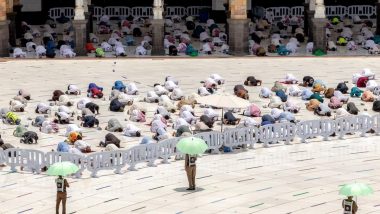Mumbai, July 13: The Hajj, the annual Islamic pilgrimage, will start this month in Saudi Arabia. In view of the coronavirus pandemic, the Kingdom of Saudi Arabia (KSA) has restricted the Hajj 2021 to a maximum of 60,000 vaccinated Muslim citizens and residents between the ages of 18 and 65. This year too, no foreigner Muslim is allowed to perform the pilgrimage, which is one of the five pillars of Islam. All financially-stable and physically-fit Muslims must perform the Hajj, also spelt as Haj, at least once in their lifetimes. Hajj 2021: Saudi to Limit Upcoming Haj Season to Domestic Pilgrims in Wake of COVID-19 Pandemic.
When Is Hajj 2021 or When Does Hajj Start?
Hajj falls on the 8th of Dhul al-Hijjah, the twelfth and final month in the Islamic lunar calendar. According to the Supreme Court of Saudi Arabia, the Dhul al-Hijjah month started from July 11. Therefore, the Hajj 2021 will start on July 18. The pilgrimage-related rituals will commence after sunset on July 17 itself.
Hajj Rituals and Significance:
At the beginning of Hajj, the Muslim pilgrims wear Ihram, two white seamless clothes for the male and normal dress for females. Ihram symbolises equality of all pilgrims in front of God, with no difference between the rich and the poor. It is believed that with donning of Ihram, pilgrims enter into a state of holiness. Once they wear Ihram, Hajj pilgrims cannot use perfume, cut their nails, trim their hair or beards and indulge in sexual activities.
On the first day (8th Dhu al-Hijjah), pilgrims are required to confirm their intention to undertake the pilgrimage. Then, they perform tawaaf (walking) around the Kaaba in Mecca seven times. They trots (walks briskly) back and forth between the hills of Safa and Marwah seven times.
On the second day, after morning prayer, pilgrims depart from Mina to reach Mount Arafat where they offer prayers, repent on and atone for their past sins, and seek the mercy of Allah. They assembly near Jabal al-Rahmah (The Mount of Mercy). The ritual of spending the afternoon in Arafat is known as 'standing before God' (Wuquf). Around sunset, pilgrims heads towards Muzdalifah, an area between Arafat and Mina.
Upon reaching there, they perform Maghrib and Isha prayers jointly, spend the night praying and sleeping on the ground under the sky. They also collect pebbles for the next day's ritual of the stoning of the Devil (Shaitan). On day 3, pilgrims perform the symbolic stoning of the devil (Ramy al-Jamarat) by throwing seven stones from sunrise to sunset at only the largest of the three pillars, known as Jamrat al-Aqabah.
The third day of Hajj coincides with Eid al-Adha festival. Hence, pilgrims perform the animal sacrifice ritual of Eid al-Adha and shave their heads. On the same or the following day, the pilgrims re-visit the Kaaba for another tawaf, known as Tawaf al-Ifadah, and trots back and forth between the hills of Safa and Marwah. Eid al-Adha: Why Do Muslims Sacrifice Animals on Bakrid? Know Significance of Religious Act Linked to Prophet Abraham.
Then, they return to Mina. On the fourth day, the pilgrims again throw seven pebbles at each of the three pillars in Mina. The same ritual is performed on the fifth day. On the last day of Hajj, before leaving Mecca, pilgrims perform a farewell tawaf called the Tawaf al-Wadaa.
(The above story first appeared on LatestLY on Jul 13, 2021 11:54 AM IST. For more news and updates on politics, world, sports, entertainment and lifestyle, log on to our website latestly.com).













 Quickly
Quickly




















